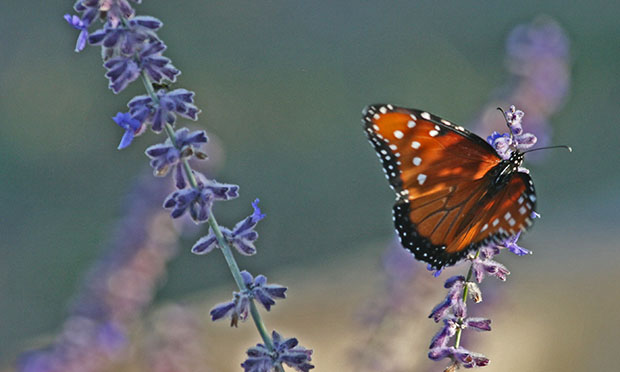Milking It
06 Oct 2020
Monarch butterflies lay their eggs on milkweed, as it is the only plant a monarch caterpillar will eat. Without milkweed, there is no monarch migration.
By KIRK MOORE

Like any love story, garden tales are usually balanced with joy, sorrow, often pain and redemption. This one is no different.
For decades I have been a botanical ditch watcher, looking for rare specimens on the cusp of destruction by DOT tractors and bush hogs. On one such search and rescue, grubbing out a clutch of orange milkweed (Asclepias tuberosa) I was also wallowing in poison ivy. Now that was normally not an issue. Poison ivy and poison oak never affected me, but all the stars aligned that day. From that then on, poison ivy has been my foe. I spent weeks getting steroid shots and looked like a mummy, with hands and face wrapped in gauze. But it was worth it! My careful digging (the 'tuberosa' part of the name means that the root system is tuberous and requires careful extraction... lest tubers are bruised and will rot) gives me to this day, an amazing patch of bright orange blooms and an annual flurry of butterflies.
On the plateau, we are lucky to be able to grow many varieties of milkweed. Along with Asclepias tuberosa, I love the common Asclepias syriaca with its pink blossoms and funky gourd-shaped seed pods. It is a perfect border plant that fits between low plants and their taller bed buddies in the back. Asclepias incarnata or the swamp milkweed, is easily grown from seed and comes in a rich magenta color, pink and even white. I have noticed in my garden, though, that the white variety does not have the same cache' to butterflies and moths, which just proves the common thought that nature gives us a preponderance of magenta-pink flowers because they are most easily seen by insects in daylight. Every living thing is on this earth for a reason.
Available in nurseries around and about the plateau is a tropical variety of Asclepias called bloodflower because of its balloon-shaped brilliant red blossoms, which, when opened, has an equally brilliant yellow pistol, stigma and stamens. Alas, I must suggest that we not grow it here because it has been proven to be harmful to the migration pattern of the monarch butterfly when used outside of its native tropical range. Though it freezes with our winters, its very existence in our gardens has a marked effect on the physiological aspects of our dwindling population of butterflies.
Though the genus is named after Asclepius, the Greek god of healing, milkweeds are toxic to humans. The milky latex substance that drips from the stems of the plant (hence the name milkweed) contains cardenolides, which is a heart-stopping glycosidic compound. EEK!
There are native northern varieties that were used by aborigines for curative purposes. Imagine! The Menominee from Wisconsin used the heart leaf-shaped variety for sore throats. In Nebraska, the Omaha people made a tonic with the blossoms to help new mothers produce milk and for babies who had colic. The Ponca people in the upper Midwest made a poultice from the leaves to cure snakebite and, ironically enough, made a tonic of the leaves to use as a contraceptive. Today, smart folk are using the soft floss from the milkweed seed pods to use as a hypoallergenic filler for pillows that have been proven to be more luxurious than goose down.
Grow milkweed for our butterflies!
Grow milkweed for your soul.













